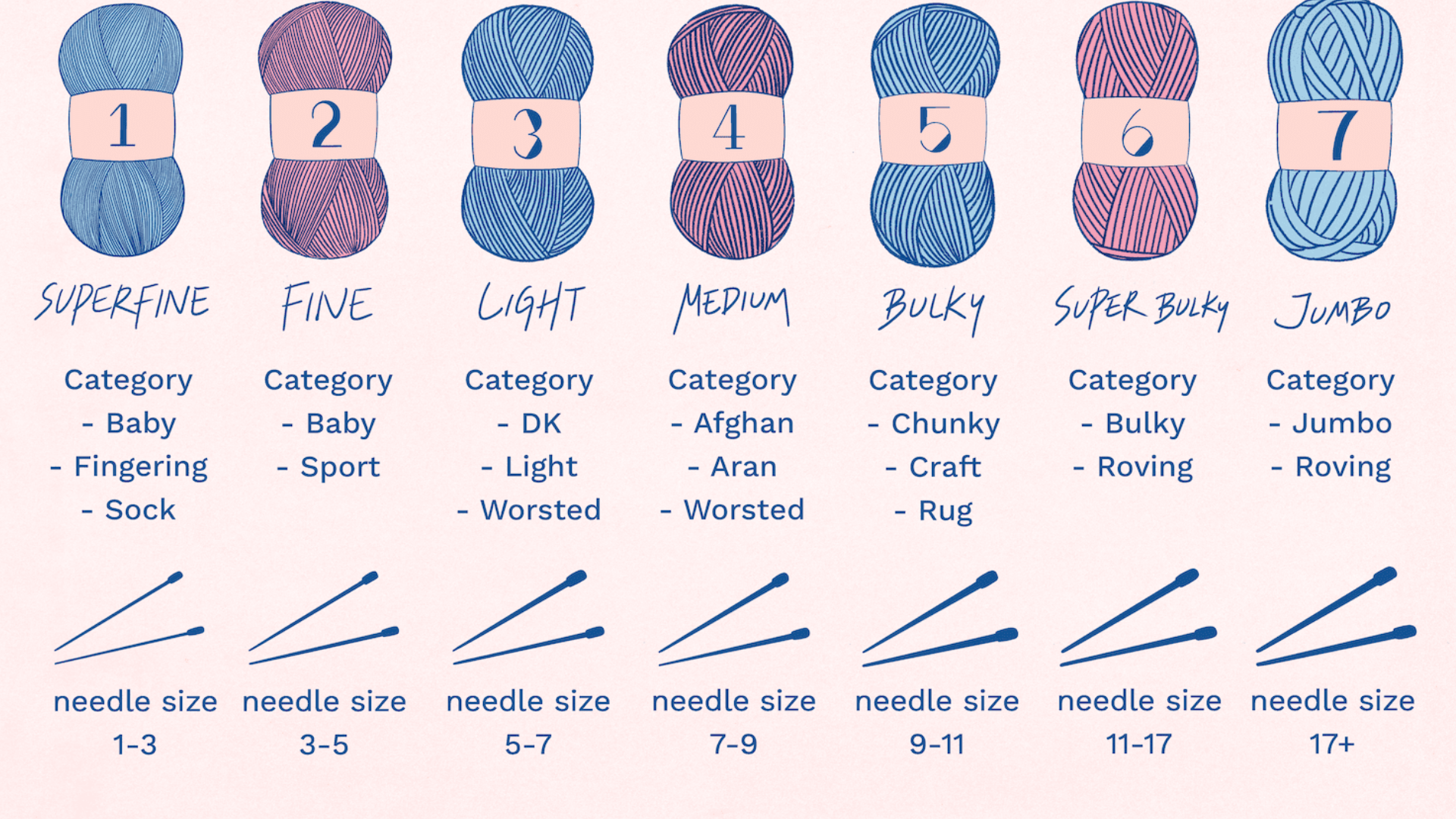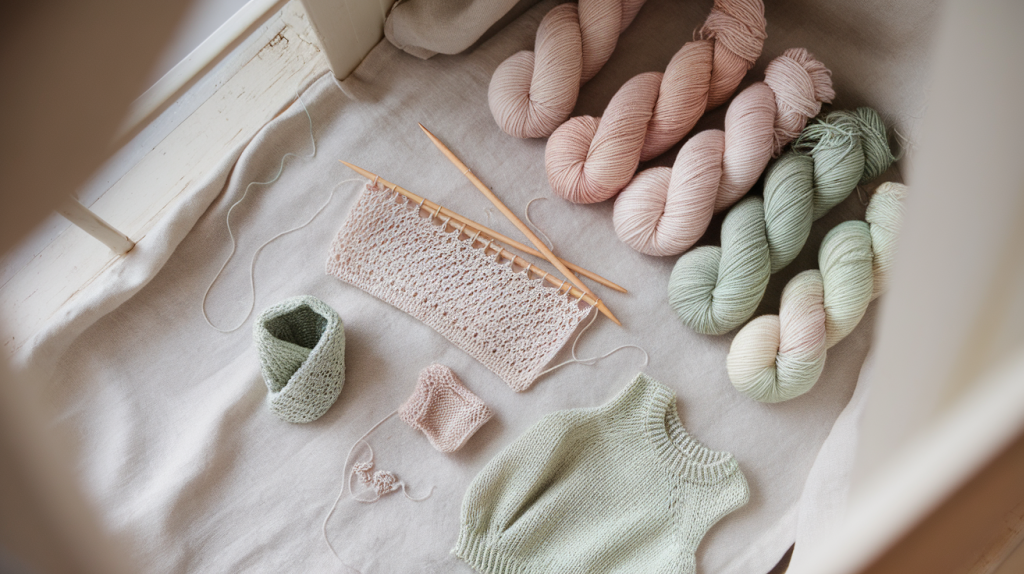Ever stood in the yarn aisle, overwhelmed by all the choices? You’re not alone. Sport weight yarn might be exactly what you’ve been looking for, and I’ll show you why.
As a knitter and crocheter for over 15 years, I’ve worked with every weight of yarn out there. Sport weight has become my go-to for so many projects, and I want to share that knowledge with you.
In this guide, you’ll learn:
- What makes sport weight yarn special
- The best projects to use it for
- How to substitute it for other yarn weights
- My top 5 favorite sport weight yarns
Whether you’re making baby clothes, lightweight sweaters, or intricate shawls, sport weight yarn hits that sweet spot between delicate and durable. By the end of this article, you’ll know exactly how to use this versatile yarn in your next project.
Let’s dive in and discover why sport weight yarn might become your new crafting best friend.
Understanding Sport Weight Yarn

What’s Special About Sport Weight?
Let me cut to the chase – sport weight yarn is the hidden gem of the yarn world. I’ve spent countless hours working with different yarns, and this one’s special.
1. The Basics
Think of sport weight as the “middle child” of yarn – not too thin, not too bulky. It’s labeled as a “2” or “fine” on yarn labels.
2. The Feel
I love how it feels in my hands when I knit. You will too. It’s light enough for delicate projects but strong enough to last.
3. Key Features
Here’s what makes sport weight yarn stand out:
- Thinner than worsted but thicker than fingering yarn
- Creates fabric that drapes beautifully
- Perfect for year-round projects
- Shows off detailed stitches clearly
4. Technical Details
The magic number is 24-26 stitches per 4 inches on size 2.5-4 needles (3.0-3.5mm). But don’t worry too much about these numbers. What matters is how it works up.
5. Perfect Projects
You know those sweaters that look fancy but feel comfortable? That’s sport weight yarn at work. It’s my go-to for baby clothes too.
The fabric is soft and light but holds up well in the wash.
6. Why Choose It
Want to make something special? Try sport weight yarn.
Whether you’re knitting a summer top or a winter scarf, this yarn weight delivers.
Characteristics of Sport Weight Yarn
1. Texture
Sport weight yarn offers a smooth, even texture that feels great in your hands.
Unlike bulky yarns that can feel rough, or lace weight that can be wispy, sport weight hits that sweet spot of being both substantial and refined.
2. Weight and Drape
The magic of sport weight lies in its drape. The fabric it creates flows beautifully without being clingy.
It’s lighter than DK yarn but has more body than fingering weight, making garments that move with you rather than against you.
3. Durability
Don’t let its fine appearance fool you. Sport weight yarn is surprisingly tough.
I’ve made sweaters that have lasted years of regular wear.
The tighter stitch gauge means your projects will hold their shape and resist pilling better than looser-knit fabrics.
4. Stitch Definition
Here’s where sport weight really shines. It shows off intricate stitch patterns – cables, lace, textured stitches – with crystal clarity.
Each stitch stands out distinctly, making your hard work visible and beautiful.
5. Versatility
You can use sport weight yarn for almost any project. It works up into fabrics that are:
- Light enough for summer garments
- Warm enough for winter accessories
- Perfect for layering pieces
- Ideal for baby items
6. Working Properties
Sport weight yarn is easy to handle – it rarely splits or tangles. You can see your stitches clearly, making it easier to spot and fix mistakes.
Plus, it’s thin enough to work quickly but not so fine that it becomes frustrating.
Pros and Cons of Using Sport Weight Yarn
1. The Good Stuff
-
Versatility
Sport weight yarn shines in almost any project. I’ve used it for delicate shawls and sturdy sweaters alike. Your options are practically endless.
-
Beautiful Drape
The fabric just flows. Unlike bulkier yarns that can feel stiff, sport weight creates garments that move naturally with your body.
-
Stitch Detail
Every cable, lace pattern, and texture pops. The yarn is fine enough to show off your fancy stitchwork but not so thin that it becomes fussy to work with.
-
Temperature Control
Projects made with sport weight yarn are perfect for layering. They’re warm without being hot and light without being flimsy.
2. The Challenges
-
Time Investment
Let’s be honest – finer yarn means more stitches. Your projects will take longer than with worsted or bulky yarn.
-
Cost Considerations
You’ll need more yardage for projects compared to thicker yarns. This can make larger items like sweaters more expensive.
-
Learning Curve
If you’re used to working with thicker yarns, sport weight might feel slippery at first. Tension control takes practice.
Common Uses of Sport Weight Yarn
1. Baby Clothes
Sport weight yarn is perfect for baby items. It creates clothes that are:
- Light enough to be comfortable
- Durable enough for frequent washing
- Thin enough to show sweet stitch patterns
- Just right for layering in any season
2. Lightweight Sweaters
I love using sport weight for sweaters. The fabric drapes beautifully without clinging. Your sweaters will look polished but feel like wearing your favorite t-shirt.
They’re perfect for spring days or layering in winter.
3. Delicate Shawls
Sport weight shines when making shawls. It’s light enough to create airy patterns but has enough body to hold its shape. The stitch definition makes your lace work look stunning.
4. Socks and Accessories
Want socks that last? Sport weight is your friend. They’re:
- Thicker than fingering weight socks
- More durable for everyday wear
- Still fit comfortably in shoes
- Perfect for wrist warmers and mittens too
5. Summer Tops
Those breezy summer tops you see in magazines? Sport weight yarn is ideal for them. The fabric is light enough to wear in warm weather but substantial enough to keep its shape.
6. Kids’ Clothing
Children’s clothes made with sport weight yarn are practical and cute. The yarn is:
- Strong enough for active kids
- Light enough to be comfortable
- Easy to care for
- Perfect for detailed patterns
7. Special Occasion Items
Wedding shawls, christening gowns, and special occasion garments benefit from sport weight’s elegant drape and beautiful stitch definition. These items become treasured heirlooms.
How to Work with Sport Weight Yarn
1. Getting Started
Before diving into your project, check your tension. Sport weight yarn needs a gentle touch – not too tight, not too loose. Always make a gauge swatch first. Trust me, this small step saves hours of frustration later.
2. Choosing Your Tools
I recommend starting with:
- US size 2.5-4 (3.0-3.5mm) needles
- Smooth, light-colored needles to see stitches clearly
- A row counter (sport weight’s finer gauge makes rows easy to lose track of)
3. Tension Tips
Hold your yarn with a light touch. Sport weight doesn’t need a death grip to control it. If your stitches look uneven:
- Try wrapping the yarn around your fingers differently
- Adjust your needle grip
- Take breaks if your hands get tired
Common Mistakes to Avoid
Here’s what I learned the hard way:
- Don’t pull your yarn too tight – it ruins the drape
- Don’t skip the blocking step
- Don’t rush – sport weight shows every mistake
- Don’t substitute yarns without swatching
1. Working in Pattern
Sport weight yarn shows off stitch patterns beautifully. Keep track of your work by:
- Using stitch markers liberally
- Taking progress photos
- Counting stitches regularly
- Using a lifeline for complex patterns
2. Care While Working
Your work-in-progress needs care too. I suggest:
- Using a project bag to protect your work
- Keeping your yarn cake clean
- Avoiding harsh tugging on the working yarn
- Taking regular breaks to prevent hand fatigue
Remember: This yarn rewards patience. Take your time, and you’ll create something beautiful.
Popular Sport Weight Yarn Brands & Recommendations
1. Budget-Friendly Favorites
Lion Brand Cotton-Ease steals the show here. I’ve used it for countless baby projects.
The cotton-acrylic blend feels soft, washes well, and won’t break the bank.
2. Premium Picks
Rowan Felted Tweed Sport is worth every penny. The wool-alpaca blend creates incredible fabric with a subtle tweed effect. Perfect for heirloom sweaters that last for years.
3. Best for Baby Items
Plymouth Dreambaby DK (despite the name, it’s sport weight) is my go-to for baby clothes because:
- Machine washable
- Super soft against delicate skin
- Comes in gentle colors
- Holds up to frequent washing
4. Natural Fibers
Berroco Ultra Alpaca Fine blends wool and alpaca beautifully.
The fabric is warm but not heavy, with a lovely subtle halo that develops over time.
5. Best for Colorwork
Jamieson’s Shetland Spindrift is perfect for colorwork because:
- Sticky enough to stay put
- Shows crisp pattern definition
- Comes in over 200 colors
- Blocks beautifully
6. Everyday Workhouse
Cascade Heritage Sport never disappoints. It’s:
- Durable enough for socks
- Soft enough for next-to-skin wear
- Available in solid and heather colors
- Easy to care for
7. Local Yarn Store Gems
Keep an eye out for Malabrigo Arroyo. The hand-dyed colors are stunning, and the merino wool is a joy to work with. Warning: The colors are addictive – you’ll want them all!
Where to Buy Sport Weight Yarn?
1. Local Yarn Stores
Your local yarn shop (LYS) is a goldmine. Here’s why I love shopping at mine:
- You can touch and feel the yarn
- Staff offer expert advice
- You’ll find unique, high-quality brands
- The staff can help with color matching
- You support small businesses
2. Online Retailers
Popular websites that never let me down:
- WEBS (yarn.com) – great bulk discounts
- KnitPicks – quality yarns at reasonable prices
- LoveCrafts – huge selection, frequent sales
- Etsy – unique hand-dyed options
3. Big Box Stores
Places like Michaels, JOANN, and Hobby Lobby stock sport weight yarn that’s:
- Readily available
- Budget-friendly
- Perfect for learning
- Good for everyday projects
4. Specialty Online Shops
Want something special? Try:
- The Loopy Ewe – curated selection
- Jimmy Beans Wool – excellent customer service
- Yarn.com – amazing bulk discounts
- Brooklyn Tweed – American-made luxury
5. Fiber Festivals
If you can attend one, fiber festivals are fantastic for:
- Meeting small producers
- Finding unique hand-dyed yarns
- Getting inspiration
- Touching lots of different yarns
6. Direct from Mills
Some yarn companies sell directly through their websites. This can mean:
- Better prices
- Full color selection
- Special limited editions
- Mill-end deals
7. Buy Smart Tips
Remember to:
- Buy enough for your whole project
- Check dye lots
- Watch for seasonal sales
- Join loyalty programs
Sign up for newsletters to catch deals
Sport Weight Yarn vs. Other Yarn Weights
1. Sport Weight vs. Fingering Weight
Sport Weight:
- Slightly thicker
- Works up faster
- Creates sturdier fabric
- Better for beginners
Fingering Weight:
- Creates more delicate fabric
- Perfect for intricate lace
- Traditional sock yarn
- Takes longer to work up
2. Sport Weight vs. DK Weight
Sport Weight:
- Finer gauge
- More delicate drape
- Shows stitch detail better
- Uses smaller needles
DK Weight:
- Works up quicker
- Warmer fabric
- More widely available
- Uses larger needles
3. Sport Weight vs. Worsted Weight
Sport Weight:
- Creates lighter fabric
- Better drape
- More refined look
- Takes more time
Worsted Weight:
- Much faster projects
- Warmer, bulkier fabric
- Easier for beginners
- Less yardage needed
4. When to Choose Each
Choose Sport Weight for:
- Summer garments
- Baby items
- Detailed stitch work
- Professional-looking pieces
Choose Other Weights for:
- Quick winter accessories (worsted/bulky)
- Traditional socks (fingering)
- Fast baby blankets (DK/worsted)
- Learning new techniques (worsted)
Conclusion
Sport weight yarn is a versatile treasure in any crafter’s toolkit. I’ve found it to be the perfect middle ground when you want something more substantial than fingering weight but lighter than DK.
It creates fabrics with beautiful drape and stitch definition, making it ideal for everything from delicate shawls to everyday sweaters.
While it might take a bit more time to work with than thicker yarns, the results are worth the extra effort. Your projects will have that professional, polished look that makes people ask,
“Where did you buy that?” The fabric it creates is perfect for year-round wear, and its durability means your handmade items will last for years to come.
Whether you’re new to sport weight yarn or it’s already a staple in your stash, don’t be afraid to experiment with it.
Start with a simple project, take your time with gauge swatching, and watch how this versatile yarn weight transforms your knitting or crochet.
The possibilities are endless, and once you get comfortable working with sport weight yarn, you might just find it becoming your new go-to choice for most projects.
Remember, every knitter or crocheter’s journey is unique, but having sport weight yarn in your toolkit opens up a world of creative possibilities. Give it a try – your next favorite project might just be a sport weight yarn away.
Frequently Asked Questions About Sport Weight Yarn
What exactly is sport weight yarn?
Sport weight yarn is a “2” or “fine” weight yarn that sits between fingering and DK weight. It typically knits at 24-26 stitches per 4 inches on US size 2.5-4 (3.0-3.5mm) needles.
Why is it called “sport” weight?
The name comes from traditional sportswear garments made with this weight of yarn. Athletes liked the lightweight, breathable fabric it created for active wear.
Can I substitute sport weight yarn for DK weight?
Yes, but you’ll need to make adjustments. You’ll likely need:
- More yarn yardage
- Smaller needles
- A gauge swatch
- Pattern stitch count changes
Is sport weight yarn good for beginners?
While you can start with sport weight, I usually recommend worsted weight for complete beginners. Sport weight requires more precise tension control but is great for beginners ready to advance their skills.
How do I know how much sport weight yarn to buy?
Check your pattern’s yardage requirements and buy an extra skein for swatching and insurance. Remember that sport weight projects typically need more yardage than the same project in a heavier weight yarn.
Can I machine wash sport weight yarn?
It depends on the fiber content, not the weight. Check your yarn label for care instructions. Many sport weight yarns are machine washable, but some need hand washing.
What’s the best project to start with using sport weight yarn?
I recommend starting with a simple scarf or hat. These projects let you get used to the yarn’s properties without committing to a larger project like a sweater.
Why is my sport weight project taking so long?
Because sport weight yarn is finer, you need more stitches per inch than with thicker yarns. This means more knitting time, but also a more refined finished product.
How do I fix uneven tension with sport weight yarn?
Try:
- Using needle tips with smoother surfaces
- Relaxing your grip
- Taking frequent breaks
- Blocking your finished work
Can I use sport weight yarn for socks?
Absolutely! Sport weight socks are:
- More durable than fingering weight
- Quicker to knit
- Great for hiking socks
- Perfect for winter wear









